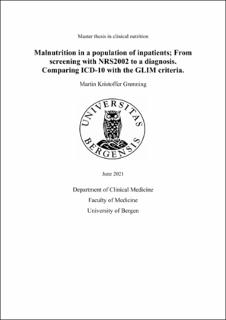| dc.description.abstract | Background: Malnutrition is highly prevalent in hospital settings, with adverse effects on patient outcomes. Up until recently, there have been no universally accepted diagnostic criteria for malnutrition to aid clinical practice. In response to the needs of the clinical nutrition and medical communities, the Global Leadership Initiative on Malnutrition (GLIM) has proposed a set of core diagnostic criteria for diagnosing adult malnutrition across different healthcare settings. These criteria are consensus based and need validation. Study aims: This study aimed to investigate the criterion validity of the GLIM criteria for the malnutrition diagnosis using ICD-10 diagnostic codes E.44.0 and E.43 as reference, and to investigate the prevalence of malnutrition and nutritional risk as identified by NRS-2002 among hospitalized patients at Haukeland University Hospital. Methods: This study is a cross-sectional analysis of anthropometrical and nutritional indicators from inpatients at six departments at Haukeland University Hospital, collected as part of the MALNUTRA-study. Nutritional risk status was determined based on NRS-2002 scores collected from previous study personnel. Based on the available data, patients were assessed retrospectively using the ICD-10 diagnostic codes E.44.0 and E.43, and by applying six combinations of GLIM’s phenotypic and etiologic criteria: A) Weight loss and reduced food intake B) Weight loss and inflammation C) Low BMI and reduced food intake D) Low BMI and inflammation E) Reduced muscle mass and reduced food intake F) Reduced muscle mass and inflammation. Reduced muscle mass was assessed by mid arm muscle circumference, and CRP ≥ 5 mg/dl was used as an indicator of inflammation. Agreement (Cohen’s Kappa, percent agreement) and validity (sensitivity, specificity, positive predictive value and negative predictive value) statistics were performed to assess criterion validity. Results: 326 patients (71 years (IQR 18), 53% men) were assessed. NRS-2002 identified 44% as in nutritional risk. ICD-10 identified 37% as malnourished, of which 28% were moderately malnourished (E.44.0) and 9.5% were severely malnourished (E.43). GLIM identified 35% as malnourished, of which 13% were moderately malnourished and 22% were severely malnourished. The GLIM criteria displayed fair criterion validity (sensitivity 59.0%, specificity 79.4%) and agreement (k=0.389, agreement 72%) when compared to the ICD-10 diagnostic codes E.44.0 and E.43. When compared based on moderate malnutrition status, GLIM’s criterion validity was rated as poor (sensitivity 18.7%, specificity 89.8%) and agreement was poor (k=0.102, agreement 70%) when compared to ICD-10 E.44.0. However, when compared based on severe malnutrition status the GLIM criteria displayed good criterion validity (sensitivity 87.1%, specificity 84.4%) and moderate agreement (k=0.445, agreement 85%) when compared to ICD-10 E.43. Conclusion: The newly proposed GLIM criteria displayed fair criterion validity and agreement for the diagnosis of malnutrition, using ICD-10 as reference. However, this was not consistent across severity grades. | |
